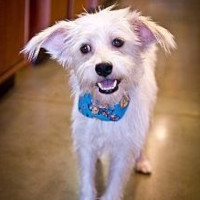Appearance of the Nortese
|
| The Nortese is a very small dog, even the largest of them measuring less than 30 centimeters and weighing less than 7 kilos. These small companion dogs can vary considerably in structure, appearance and temperament from one dog to the next, even within the same litter, due to differences in parental breeds. Although the Nortese is certainly a little longer than it is tall, its bone structure can range from the robust, thick bones of the Norwich Terrier to the fine, straight bones of the Maltese. The skull is slightly rounded, although slightly narrower for dogs that prefer the Maltese, and the hybrid may sport either the finely tapered muzzle of the Maltese or the strong wedge-shaped muzzle of the Norwich Terrier. Their round or oval eyes are generally very dark, with a lively, intelligent expression, and although they may inherit the straight triangular ears of the Norwich Terrier or the low-set floppy ears of the Maltese, most end up with ears that rest high on their head and flap forward or to the sides. |
Temperament of the Nortese
|
| The temperament of this hybrid can vary considerably from one individual to another, as the parent breeds can have very different personalities. The Maltese is a very friendly dog that gets along with just about everyone, regardless of age, size or species, while the Norwich Terrier is more likely to be more reserved, especially with strangers. While Maltese Terriers can generally trust smaller children, Norwich Terriers can sometimes be possessive and jealous, and may occasionally resort to slapping. Interactions with small children need to be supervised even with the calmest of these dogs, not only for the safety of the child, but for the safety of the dog. In most cases, this hybrid will be pleasant with other animals, but some may not be able to resist the urge to chase them, and if not socialized, some Nortese dogs can develop aggression or frightening behaviors. Although sometimes stubborn, they should be fairly easy to train as they are quite bright and eager to learn new things, although home training can be more of a challenge with these dogs than with most. |
Needs and activities of the Nortese
|
| Although this hybrid is a lively, energetic dog, it is able to expend large amounts of that energy without too much effort on your part, mainly because of its small size. Forty-five minutes a day is usually enough to keep these little dogs satisfied, and is most effective when divided into at least two or three shorter sessions throughout the day. While dogs that inherit the Norwich Terrier's double-layered coat are generally fine in mildly cold weather, those with just a single layer of silky hair can be more sensitive to the cold and may require outerwear designed for dogs to keep them comfortable on walks. |
Maintenance of the Nortese
|
| It's not a wash-and-wear hybrid, but the amount of grooming required for a Nortese is generally a little simpler than it may first appear. Grooming methods may differ a little depending on the coat your Nortese inherits, dogs with the silkier coat characteristic of the Maltese will need baths more often than most other breeds, usually around once a month, while those with the wiry double coat of the Norwich Terrier only need to be bathed a few times a year. Both coats need brushing, although this is a daily affair for the softer Maltese coat to prevent tangles and matting, and those with the Norwich coat can get away with it a few times a week. Nortese coats can sometimes reach Maltese lengths, requiring scissors and frequent trimming, but more often than not, their silky coats stay at a short to medium length and only need occasional trimming to tidy things up. Those who inherit the Norwich Terrier's extremely dense coat may also require scissor work, trimming the coat to keep it neat and tidy, and thinning it with tapering scissors.e century. A number of similar dogs were used in its creation, including the Border Terrier and the Cairn Terrier. Interestingly, they were created with the intention of having a breeding dog hardy enough to live outdoors in barns and outbuildings and hunter enough to hunt vermin. Many agree that the breed became popular among students at Cambridge's elite university, and that several breeders were Cambridge alumni. It was in the mid-1900s that the original breed was split into two groups: dogs with erect ears, now the Norwich Terrier, and those with hanging ears, the Norfolk Terrier. Although Norfolk Terriers make good pets, they are not a particularly well-known breed worldwide. |









 English (United Kingdom)
English (United Kingdom)